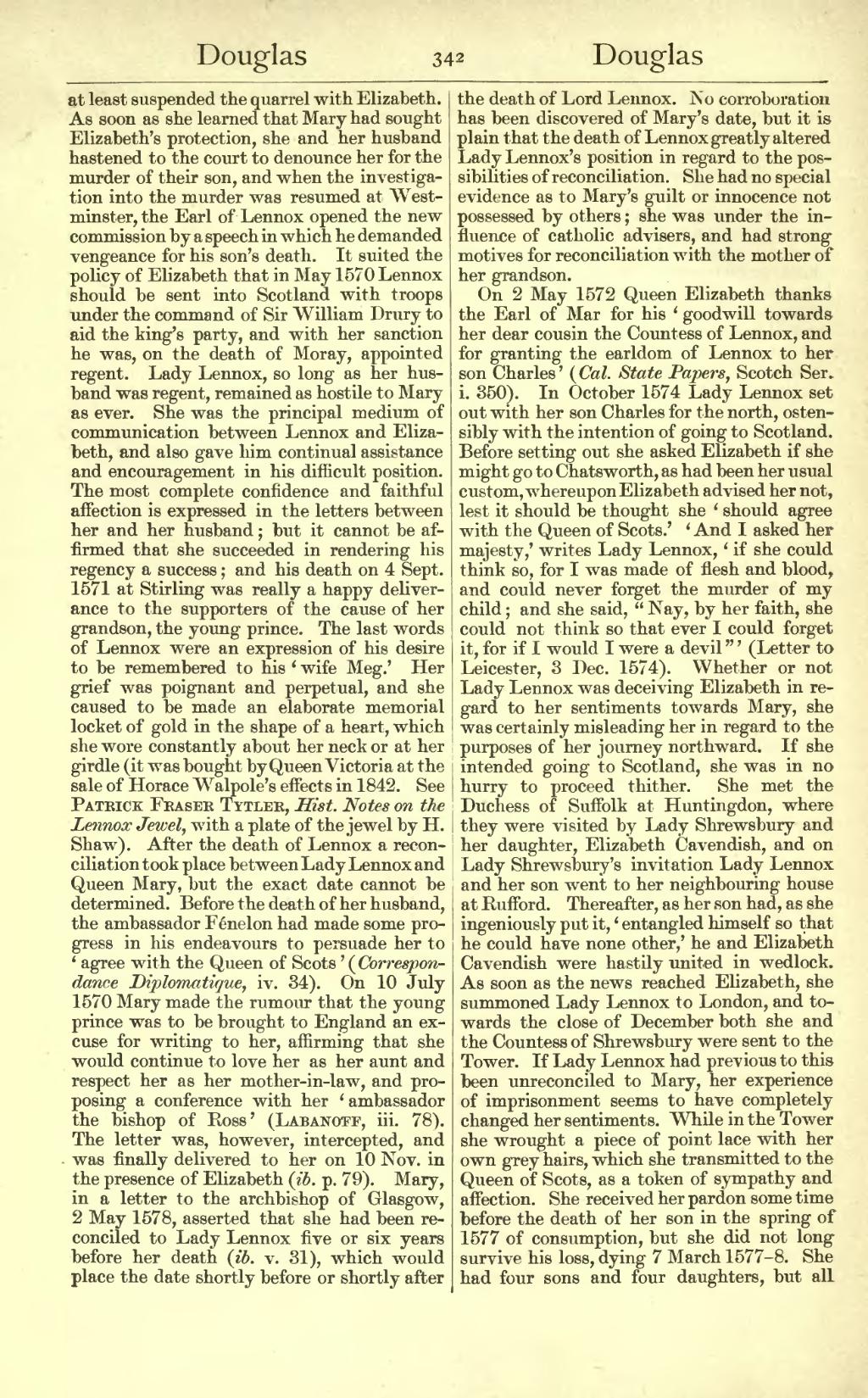at least suspended the quarrel with Elizabeth. As soon as she learned that Mary had sought Elizabeth's protection, she and her husband hastened to the court to denounce her for the murder of their son, and when the investigation into the murder was resumed at Westminster, the Earl of Lennox opened the new commission by a speech in which he demanded vengeance for his son's death. It suited the policy of Elizabeth that in May 1570 Lennox should be sent into Scotland with troops under the command of Sir William Drury to aid the king's party, and with her sanction he was, on the death of Moray, appointed regent. Lady Lennox, so long as her husband was regent, remained as hostile to Mary as ever. She was the principal medium of communication between Lennox and Elizabeth, and also gave him continual assistance and encouragement in his difficult position. The most complete confidence and faithful affection is expressed in the letters between her and her husband; but it cannot be affirmed that she succeeded in rendering his regency a success; and his death on 4 Sept. 1571 at Stirling was really a happy deliverance to the supporters of the cause of her grandson, the young prince. The last words of Lennox were an expression of his desire to be remembered to his ‘wife Meg.’ Her grief was poignant and perpetual, and she caused to be made an elaborate memorial locket of gold in the shape of a heart, which she wore constantly about her neck or at her girdle (it was bought by Queen Victoria at the sale of Horace Walpole's effects in 1842. See Patrick Fraser Tytler, Hist. Notes on the Lennox Jewel, with a plate of the jewel by H. Shaw). After the death of Lennox a reconciliation took place between Lady Lennox and Queen Mary, but the exact date cannot be determined. Before the death of her husband, the ambassador Fénelon had made some progress in his endeavours to persuade her to ‘agree with the Queen of Scots’ (Correspondance Diplomatique, iv. 34). On 10 July 1570 Mary made the rumour that the young prince was to be brought to England an excuse for writing to her, affirming that she would continue to love her as her aunt and respect her as her mother-in-law, and proposing a conference with her ‘ambassador the bishop of Ross’ (Labanoff, iii. 78). The letter was, however, intercepted, and was finally delivered to her on 10 Nov. in the presence of Elizabeth (ib. p. 79). Mary, in a letter to the archbishop of Glasgow, 2 May 1578, asserted that she had been reconciled to Lady Lennox five or six years before her death (ib. v. 31), which would place the date shortly before or shortly after the death of Lord Lennox. No corroboration has been discovered of Mary's date, but it is plain that the death of Lennox greatly altered Lady Lennox's position in regard to the possibilities of reconciliation. She had no special evidence as to Mary's guilt or innocence not possessed by others; she was under the influence of catholic advisers, and had strong motives for reconciliation with the mother of her grandson.
On 2 May 1572 Queen Elizabeth thanks the Earl of Mar for his ‘goodwill towards her dear cousin the Countess of Lennox, and for granting the earldom of Lennox to her son Charles’ (Cal. State Papers, Scotch Ser. i. 350). In October 1574 Lady Lennox set out with her son Charles for the north, ostensibly with the intention of going to Scotland. Before setting out she asked Elizabeth if she might go to Chatsworth, as had been her usual custom, where upon Elizabeth advised her not, lest it should be thought she ‘should agree with the Queen of Scots.’ ‘And I asked her majesty,’ writes Lady Lennox, ‘if she could think so, for I was made of flesh and blood, and could never forget the murder of my child; and she said, “Nay, by her faith, she could not think so that ever I could forget it, for if I would I were a devil”’ (Letter to Leicester, 3 Dec. 1574). Whether or not Lady Lennox was deceiving Elizabeth in regard to her sentiments towards Mary, she was certainly misleading her in regard to the purposes of her journey northward. If she intended going to Scotland, she was in no hurry to proceed thither. She met the Duchess of Suffolk at Huntingdon, where they were visited by Lady Shrewsbury and her daughter, Elizabeth Cavendish, and on Lady Shrewsbury's invitation Lady Lennox and her son went to her neighbouring house at Rufford. Thereafter, as her son had, as she ingeniously put it, ‘entangled himself so that he could have none other,’ he and Elizabeth Cavendish were hastily united in wedlock. As soon as the news reached Elizabeth, she summoned Lady Lennox to London, and towards the close of December both she and the Countess of Shrewsbury were sent to the Tower. If Lady Lennox had previous to this been unreconciled to Mary, her experience of imprisonment seems to have completely changed her sentiments. While in the Tower she wrought a piece of point lace with her own grey hairs, which she transmitted to the Queen of Scots, as a token of sympathy and affection. She received her pardon some time before the death of her son in the spring of 1577 of consumption, but she did not long survive his loss, dying 7 March 1577–8. She had four sons and four daughters, but all
